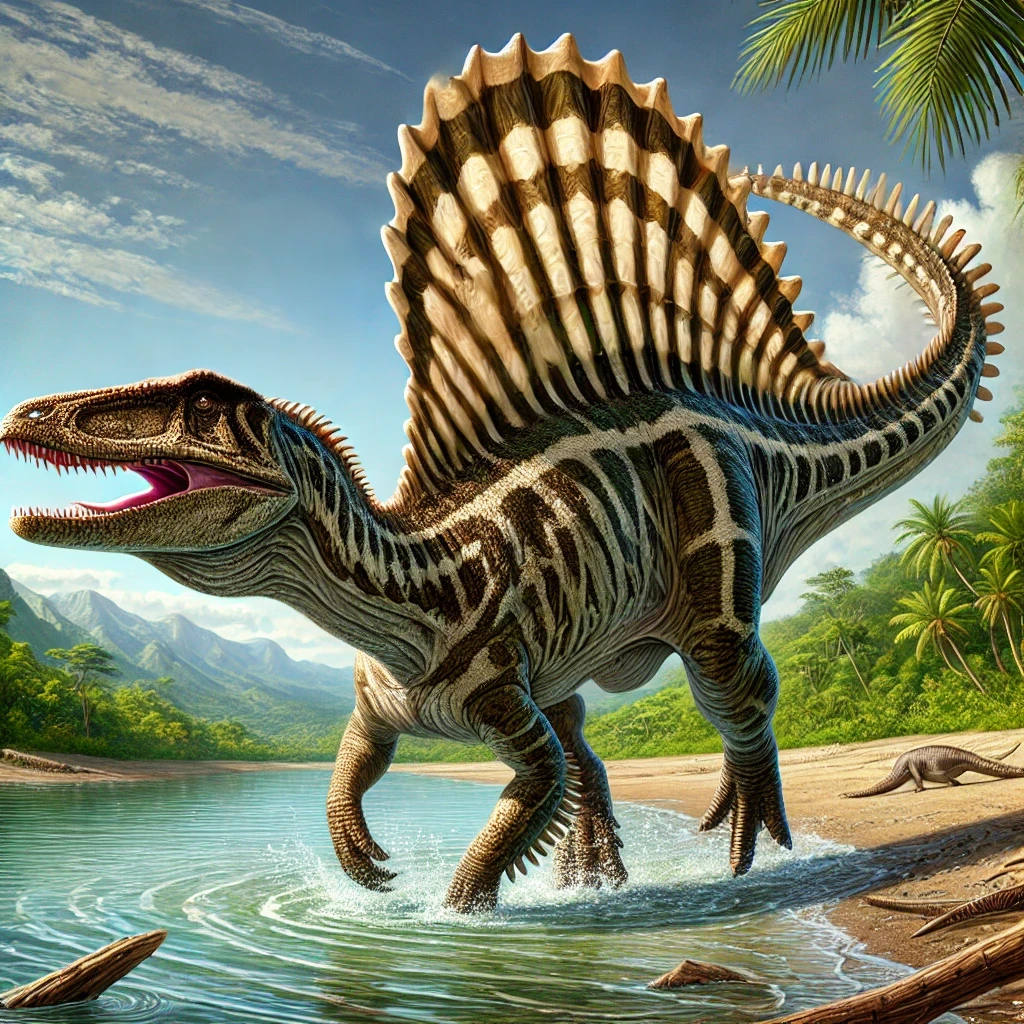Pronunciation:
Spine-oh-sore-us
Name Meaning:
“Spine lizard”
Dinosaur Classification:
- Kingdom: Animalia
- Phylum: Chordata
- Class: Reptilia
- Order: Saurischia
- Suborder: Theropoda
- Family: Spinosauridae
- Genus: Spinosaurus
- Species: S. aegyptiacus
Dinosaur Description:
The Spinosaurus is one of the largest carnivorous dinosaurs ever to have existed. With its crocodile-like skull and distinctive sail-like structure on its back, it stands out among its theropod relatives. The sail, formed by elongated neural spines, likely served various purposes, from regulating body temperature to aiding in display behavior or intimidation.
Spinosaurus lived in what is now North Africa during the Cretaceous period. Fossils of this remarkable predator suggest it was semi-aquatic, spending much of its time hunting fish in rivers and coastal environments. Its conical teeth and long, slender snout were well adapted to catching slippery prey like fish. Spinosaurus may have also been opportunistic, scavenging on land and preying on smaller dinosaurs when available.
What made Spinosaurus even more fascinating was its sheer size. Estimated to have reached lengths of up to 50–59 feet (15–18 meters), it surpassed even the mighty Tyrannosaurus rex in terms of length. Its sail, measuring up to 7 feet tall, is one of its most recognizable features. The purpose of this sail has been debated for years, with theories ranging from thermoregulation to display and mate attraction.
The semi-aquatic adaptations of Spinosaurus are a topic of ongoing research. Some paleontologists propose that it could swim effectively, using its tail and limbs to navigate water environments. This makes Spinosaurus one of the few known dinosaurs with an aquatic lifestyle, setting it apart from other land-based theropods.
Dinosaur Diet and Behavior:
Spinosaurus primarily fed on fish, as indicated by the structure of its teeth and jaws, which were designed for gripping rather than tearing. Fossil evidence, including the discovery of fish remains alongside Spinosaurus fossils, supports this piscivorous diet. It is also thought that Spinosaurus could have scavenged on terrestrial animals or hunted smaller dinosaurs when necessary.
Dinosaur Size:
Spinosaurus could reach lengths of 50 to 59 feet (15 to 18 meters), making it one of the longest theropods known.
Dinosaur Weight:
Spinosaurus is estimated to have weighed between 7 to 10 tons (14,000 to 20,000 lbs).
Fossil Discoveries:
The first fossils of Spinosaurus were discovered in Egypt in 1912 by German paleontologist Ernst Stromer. Unfortunately, many of these early fossils were destroyed during World War II. However, additional remains have been found in Morocco and other parts of North Africa, allowing paleontologists to continue studying this unique dinosaur. Notably, the partial skeletons found in recent years have provided more evidence supporting its semi-aquatic lifestyle.
What Period Did The Dinosaur Live:
Spinosaurus lived during the Late Cretaceous period, approximately 100 to 93 million years ago.
Notable Facts or Trivia:
– Spinosaurus is believed to have been semi-aquatic, unlike most theropods.
– It had a distinctive sail on its back formed by elongated spines, which may have been used for display, thermoregulation, or intimidation.
– Spinosaurus had a long, crocodile-like snout, perfect for catching fish.
– It surpassed even Tyrannosaurus rex in terms of length, making it one of the longest theropod dinosaurs.
Scientific Significance:
Spinosaurus has played a key role in changing the perception of theropod dinosaurs, which were once thought to be exclusively terrestrial. Its unique adaptations for a semi-aquatic lifestyle have provided new insights into the diversity of dinosaur behaviors and ecological niches. The discovery of Spinosaurus challenged long-standing views about the habitat and hunting strategies of large theropods, opening up new avenues for research into how these creatures lived and thrived.
Extinction & Legacy:
Spinosaurus, like most large dinosaurs, became extinct around 66 million years ago during the Cretaceous-Paleogene (K-Pg) extinction event. However, its legacy lives on as one of the most unusual and iconic dinosaurs ever discovered. The continued interest in Spinosaurus has driven further fossil exploration in Africa, and new discoveries may one day reveal even more about this fascinating predator’s life and behavior.
